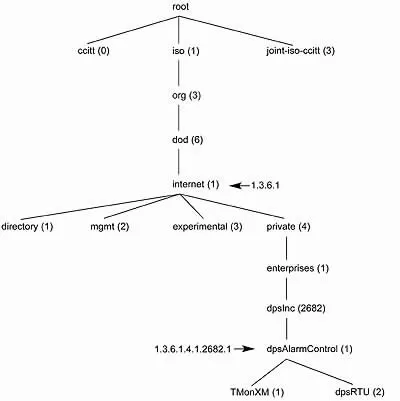Download our free SNMP White Paper. Featuring SNMP Expert Marshall DenHartog.
This guidebook has been created to give you the information you need to successfully implement SNMP-based alarm monitoring in your network.
1-800-693-0351
Have a specific question? Ask our team of expert engineers and get a specific answer!
Sign up for the next DPS Factory Training!

Whether you're new to our equipment or you've used it for years, DPS factory training is the best way to get more from your monitoring.
Reserve Your Seat TodayEach Simple Network Management Protocol (SNMP) element manages specific objects with each object having specific characteristics. Each object/characteristic has a unique object identifier (OID) consisting of numbers separated by decimal points (e.g., 1.3.6.1.4.1.2682.1).
These object identifiers naturally form a tree as shown in the below illustration. The SNMP MIB associates each OID with a readable label (e.g., dpsRTUAState) and various other parameters related to the object. The MIB then serves as a data dictionary or codebook that is used to assemble and interpret SNMP messages.

When an SNMP manager wants to know the value of a managed object/characteristic, such as the state of an alarm point, the system name, or the element uptime, it will assemble a GET packet that includes the OID for each object/characteristic of interest.
The SNMP agent receives the request and looks up each OID in its codebook (MIB). If the OID is found (the object is managed by the element), a response packet is assembled and sent with the current value of the object/characteristic included. If the OID is not found, a special error response is sent that identifies the unmanaged object.
When an element sends a Trap packet, it can include OID and value information (bindings) to clarify the event. DPS remote units send a comprehensive set of bindings with each Trap to maintain traditional telemetry event visibility. Well-designed SNMP managers can use the bindings to correlate and manage the events. SNMP managers will also generally display readable labels to facilitate user understanding and decision-making.
The MIB lists the unique object identifier (OID) of each managed element in an SNMP network. Your SNMP manager can't monitor your devices unless it has compiled their MIB files.
The MIB is also a guide to the capabilities of your SNMP devices. For example, if your device's MIB lists OIDs for Traps but not for GetResponse messages, you know it will report alarms, but will not respond to alarm polls. Learning to read MIBs is difficult, but it's worth the trouble.
There's a big difference between basic alarm monitoring and intelligent alarm management. Any basic system will give you some kind of notification of an alarm. But simple status reports don't provide effective full visibility of your network.
Your staff can't hover around a screen watching for alarms with their full attention 24/7. A simple system cannot get alarm information to the people who can correct problems quick enough to make a difference. And some problems require immediate action far faster than any human being can respond.
Using a basic alarm monitoring system makes it more likely that faults will not be corrected, potentially resulting in serious damage to your network and your revenue.
An intelligent alarm management system won't just tell personnel there's a problem; it will locate the problem, provide instructions for corrective action, route alarm information directly to the people who need it, and, if possible, correct the problem automatically. Advanced features like these can make the difference between a minor incident and major downtime, and that's a crucial edge to have in today's competitive telecom industry.

If you want these features, you need the T/Mon Remote Alarm Monitoring System. T/Mon is a multiprotocol, multifunction alarm master with advanced features like programmable custom alarms, automatic alarm correction, e-mail and pager alarm notification, alarm filtering and silencing and more.
To learn more about T/Mon, call 1-800-693-0351 today to register for a live Web demonstration.